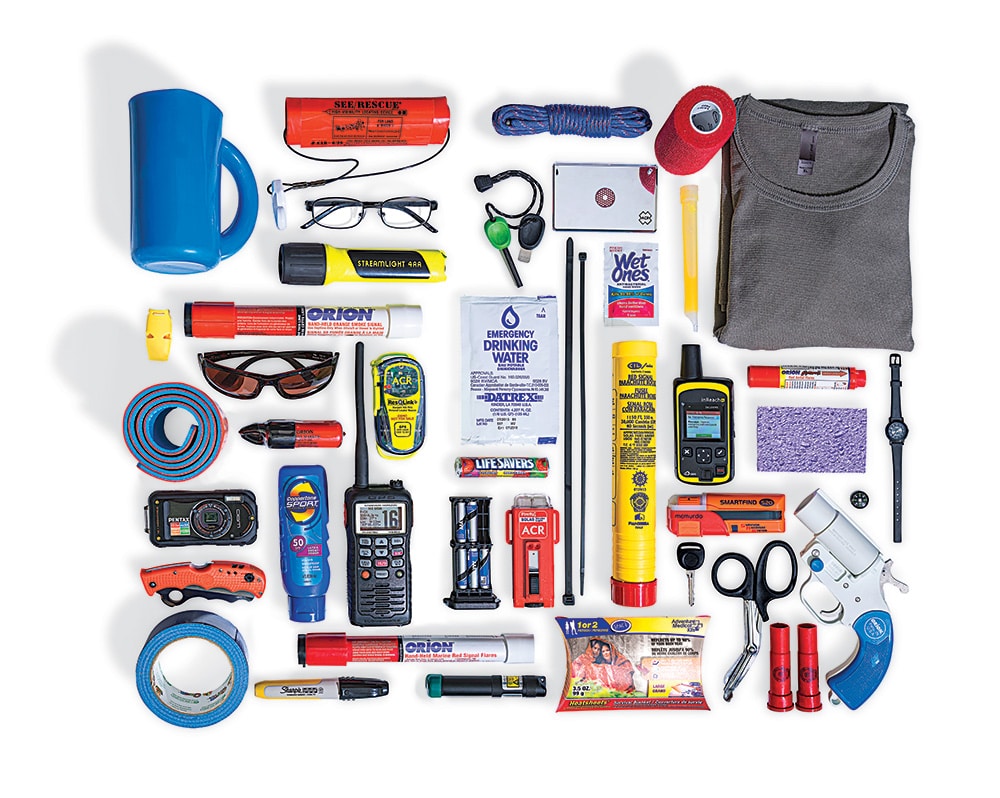
I fish offshore in a 20-foot center console. I also paddle my kayak far into the marsh. To ensure I have a backup plan if things go wrong, I searched out the best gear and practices for an emergency situation. To learn more, and set my mind at ease, I contacted Captain Christian Orfanello of Sea Tow New Orleans.
Captain Orfanello has owned his Sea Tow franchise for 15 years. In that time, he’s seen the good and bad of rescue and assists. For the ultimate safety package, Orfanello dumped the contents of his own ditch bag.
“The first thing I emphasize is communication,” Orfanello said. He highly recommends a handheld VHF radio, like an Icom M37. “The best VHF is waterproof and floats,” he says. While the handheld only has a two to five-mile boat to boat range, rescue services can pick up the signal farther away.
If a boater in a non-emergency situation radios the Coast Guard on VHF 16, he can request assistance from Sea Tow and the Coast Guard will keep in radio contact with Sea Tow and the boater until all parties are safe.
As soon as a boater calls in a distress signal, the service starts a file tracking the boater and rescue. “If anything goes wrong, they know where we are,” Orfanello explains. Maintaining communication is the best way to facilitate a speedy and safe recovery.
The captain discourages boaters from relying solely on a cellphone. “If the battery dies, or the phone gets wet it will not work.” Orfanello says cellphones are great for contacting rescue and even tracking position, when they work. “I keep a cheap cellphone in my ditch bag as a back-up means of communication.”
In the absence of cell service and VHF contact, or in a serious emergency, satellite communication devices like a personal locator beacon (PLB) or satellite communicator are the last line of rescue.
A PLB is a satellite tracking device that communicates directly with rescue services. In an emergency, activate the PLB and help is on the way. I carry an ACR ResQlink 400 PLB in my ditch bag for the worst case scenario. I’m glad I’ve never had to use it.
Satellite communicators offer more options for reliable communication. I recently added a Garmin InReach Mini to my ditch bag. For a serious emergency, the communicator has an SOS mode similar to the PLB. When I hit the SOS button, the service coordinators relay coordinates and details to rescuers.
For non-emergency communication, the satellite communicator allows me to text people on land. If my boat breaks down, I can relay instructions and location to my tow service. When the fishing is good and I return late, I let my contact know I am delayed. The communicator also acts as a basic GPS with tracking, I can even send my location to other people. The only downside is satellite communicators require a subscription service for two-way communication and other features. I paid 15 bucks per month for the basic plan with limited messages and tracking.
In conjunction with communication devices, Orfanello recommends a simple handheld GPS unit. If you become separated from your boat, or the boat power dies, the waterproof, floating GPS provides location information and navigation tools.
Orfanello says these tools are great when they are used correctly. “Be sure your contact person knows whom to call and provides the correct information,” he said. Orfanello recommends the contact person have the number and names of people on the boat, length and type of boat, GPS coordinates and nature of distress. “The contact person should understand how to relay coordinates properly so we don’t end up looking for a needle in a haystack,” he says.
In Orfanello’s personal ditch bag, he keeps flares, a waterproof flashlight, and a small mirror as means for signaling others in the area. “These things are small and cheap, but in a rescue situation, they are priceless,” he said.
In addition to communication, Orfanello stores survival essentials in his ditch bag. “Little comforts make all the difference when you are stranded,” he said.
Orfanello keeps a couple bottles of water and a few tins of Vienna sausages. He laughed, “Trust me, when you are stranded, Vienna sausages taste like filet mignon.” He also recommends a supply of medications and a small first aid kit.
After food and water, a person needs shelter. Orfanello carries a ten-foot by ten-foot tarp. “Not only can a tarp provide shelter, but it can also help keep you dry – which is an essential part of survival,” Orfanello said.
The ultimate creature comfort is a change of clothes. “Dry socks can perform miracles,” he said. Orfanello insisted these small touches are a big deal. “Anything that keeps you calm and thinking clearly is going to help you get out of the situation,” he said.
To carry his emergency gear, Orfanello uses a waterproof, folding-top dry bag. The bag floats and keeps its contents dry. “The bag should have a good strap, so you can swim with it,” he added.
Safety gear is as much for facilitating the rescue as peace of mind during the ordeal. “It’s important to have multiple layers of protection,” Orfanello said, “Don’t just rely on the VHF or cellphone, have more options.”
Orfanello’s small-boat ditch bag contains a mixture of safety gear and support items. He said, “I have the essentials I need to be rescued and stuff to keep me comfortable and safe until help arrives.”








